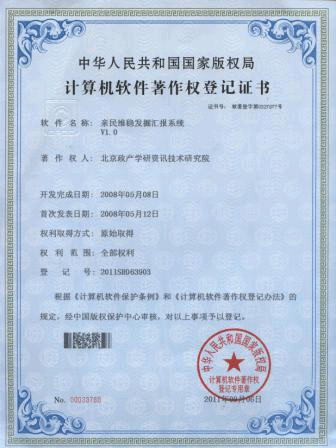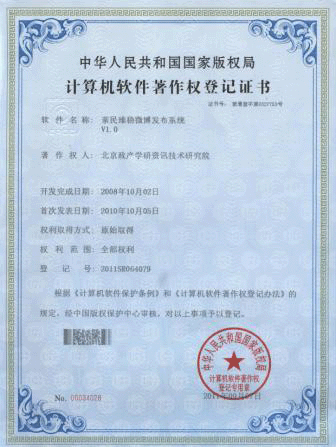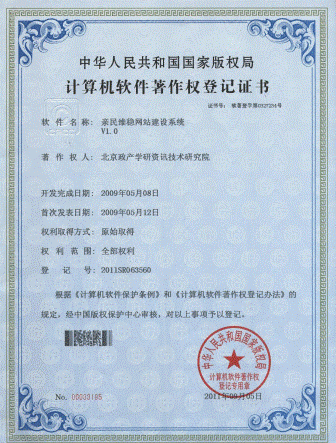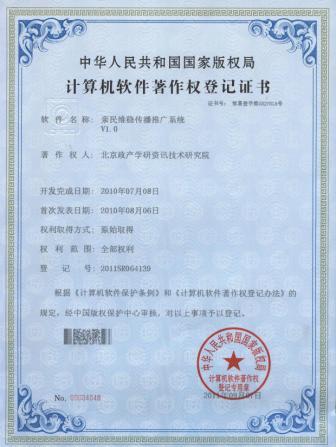亲民维稳热点推荐
- ·被闹钟惊醒后果相当于醉酒? 中医专
- ·中国首例涉外骨髓捐献在徐州采集 韩
- ·农妇产下巴掌大婴儿身长44厘米 体重
- ·卫生部就新版《献血者健康检查要求》
- ·心理专家:“吞钉男”系因渴求关注致
- ·内蒙古将对药品生产流通领域实施电子
- ·新生男婴被扔垃圾桶 目击者称未发现
- ·媒体称农村缺53万医生 不足5%医学生
- ·女子服下网购“秘方胶囊”致癫痫发作
- ·北京长富宫饭店举办首届“淮扬美食文
- ·卫生专家痛斥医院逐利行为 看病贵致
- ·两部门开展秋季中小学学校食堂食品安
- ·河南100新生儿有1个缺陷宝宝 产前诊
- ·7岁男孩在路边打闹遭车祸 睾丸破碎或
- ·卫生部要求做好国庆期间突发事件卫生
- ·调查显示中国居民膳食纤维摄入量不足
即刻使用亲民维稳解决方案!

发掘汇报软件
使用亲民维稳全套解决方案邀请
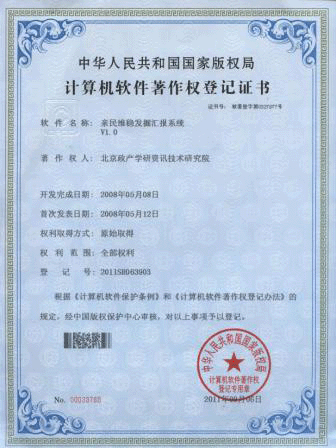
亲稳发掘汇报系统
《中国的医疗卫生事业》白皮书(全文)--亲稳网络舆情监控室
2012-12-28
中华人民共和国国务院新闻办公室26日发表《中国的医疗卫生事业》白皮书。全文如下:
The state council information office of the People's Republic of China published 26[China's medical and health services]White paper.Full text is as follows:
中国的医疗卫生事业
China's medical and health services
(2012年12月)
(In December of 2012)
中华人民共和国国务院新闻办公室
The state council information office of the People's Republic of China
目录
directory
前言
preface
一、卫生基本状况
a/Health basic condition
二、医药卫生体制改革
two/Medical and health system reform
三、传染病防治与卫生应急
three/The prevention and control of infectious diseases and health emergency
四、慢性非传染性疾病防治
four/The prevention and control of chronic non-communicable diseases
五、妇女儿童健康权益保护
five/Women and children health rights protection
六、中医药发展
six/Development of Chinese medicine
七、卫生国际合作
seven/Health international cooperation
结束语
Concluding remarks
前言
preface
健康是促进人的全面发展的必然要求。提高人民健康水平,实现病有所医的理想,是人类社会的共同追求。在中国这个有着13亿多人口的发展中大国,医疗卫生关系亿万人民健康,是一个重大民生问题。
Health is to promote people's all-round development request inevitably.Improve the people's health level,The ideal of multi-form,Is the common pursuit of human society.In China, this has more than 1.3 billion population developing country,Medical and health relationship hundreds of millions of people's health,The people's livelihood is a major problem.
中国高度重视保护和增进人民健康。宪法规定,国家发展医疗卫生事业,发展现代医药和传统医药,保护人民健康。围绕宪法,中国逐步形成了相对完善的卫生法律法规体系。
China attaches great importance to protect and improve the people's health.constitution,National development and medical and health services,The development of modern medicine and traditional Chinese medicine,Protecting the people's health.Around the constitution,China gradually formed a relatively perfect health laws and regulations system.
多年来,中国坚持“以农村为重点,预防为主,中西医并重,依靠科技与教育,动员全社会参与,为人民健康服务,为社会主义现代化建设服务”的卫生工作方针,努力发展具有中国特色的医疗卫生事业。经过不懈努力,覆盖城乡的医疗卫生服务体系基本形成,疾病防治能力不断增强,医疗保障覆盖人口逐步扩大,卫生科技水平日益提高,居民健康水平明显改善。
For many years,China adheres to the"Rural as the focal point,prevention,Both traditional Chinese and western medicine,Rely on science and technology and education,Mobilizing the whole society to participate,For people's health services,For the socialist modernization construction service"Health work policy,With Chinese characteristics to develop the medical and health services.Through unremitting efforts,Covering both urban and rural medical and health service system basic formation,Disease prevention and control increased the capacity,Health care coverage population gradually enlarged,Health science and technology level is increasing day by day,Residents health level obviously improved.
为建立起覆盖城乡居民的基本医疗卫生制度,保障每个居民都能享有安全、有效、方便、价廉的基本医疗卫生服务,中国深入推进医药卫生体制改革,取得了重要阶段性成效。
To establish the covering both urban and rural residents basic medical and health system,Ensure every people can enjoy security/effective/convenient/Cheap basic medical and health services,China further medical health system reform,Made important stage effect.
一、卫生基本状况
a/Health basic condition
居民健康状况不断改善。从反映国民健康状况的重要指标看,中国居民的健康水平已处于发展中国家前列。2010年人均期望寿命达到74.8岁,其中男性72.4岁,女性77.4岁。孕产妇死亡率从2002年的51.3/10万下降到2011年的26.1/10万。婴儿死亡率及5岁以下儿童死亡率持续下降,婴儿死亡率从2002年的29.2‰下降到2011年的12.1‰,5岁以下儿童死亡率从2002年的34.9‰下降到2011年的15.6‰,提前实现联合国千年发展目标。
Residents health conditions have constantly improved.From the national health reflects the important indicators to see,Chinese residents' health level has been in the forefront of the developing countries.In 2010, the per capita expected age is 74.8 years old,The male, 72.4 years,Women was 77.4 years.The maternal mortality rate from 2002 in 51.3/10 descend to 2011 years of 26.1/10.Infant mortality rate and mortality of children under five years old is declining,Infant mortality rate from 2002 to 29.2 ‰ of the decline in 2011 to 12.1 ‰,Children under the age of five mortality from 2002 to 34.9 ‰ of the decline in 2011 to 15.6 ‰,Advance to realize the UN millennium development goals.
建立起覆盖城乡的医疗卫生体系。一是公共卫生服务体系。包括疾病预防控制、健康教育、妇幼保健、精神卫生、卫生应急、采供血、卫生监督和计划生育等专业公共卫生服务网络,以及以基层医疗卫生服务网络为基础、承担公共卫生服务功能的医疗卫生服务体系。二是医疗服务体系。在农村建立起以县级医院为龙头、乡镇卫生院和村卫生室为基础的农村三级医疗卫生服务网络,在城市建立起各级各类医院与社区卫生服务机构分工协作的新型城市医疗卫生服务体系。三是医疗保障体系。这个体系以基本医疗保障为主体、其他多种形式补充医疗保险和商业健康保险为补充。基本医疗保障体系包括城镇职工基本医疗保险、城镇居民基本医疗保险、新型农村合作医疗和城乡医疗救助,分别覆盖城镇就业人口、城镇非就业人口、农村人口和城乡困难人群。四是药品供应保障体系。包括药品的生产、流通、价格管理、采购、配送、使用。近期重点是建立国家基本药物制度。
Set up the medical and health system covering both urban and rural areas.One is the public health service system.Including disease prevention and control/Health education/Maternity and child care/Mental health/Health emergency/CaiGongXie/Health supervision and family planning, and other professional public health service network,And to basic medical and health service network as the foundation/Take on the public health service function of the medical and health service system.Secondly, the medical service system.In the rural areas established at or above the county level for leading to hospital/Township health center and the village clinic as the foundation of the rural level 3 medical and health service network,In the city at all levels set up all kinds of hospitals and community health service division of labor cooperation of a new type of urban medical and health service system.The third is the medical security system.The system for basic medical insurance as the main body/A variety of other forms of supplementary medical insurance and commercial health insurance for the supplement.The basic medical security system including the urban employee basic medical insurance/Basic medical insurance for urban residents/The new rural cooperative medical and urban and rural medical assistance,They cover the urban employment population/Town not employed population/The rural population and urban and rural difficult people.The fourth is a system for ensuring drug supply system.Including drug manufacturing/circulation/Price management/purchasing/distribution/use.The key is to establish a national system for basic drugs.
卫生筹资结构不断优化。卫生筹资来源包括政府一般税收、社会医疗保险、商业健康保险和居民自费等多种渠道。2011年,中国卫生总费用达24345.91亿元人民币,同期人均卫生总费用为1806.95元人民币,卫生总费用占国内生产总值的比重为5.1%。按可比价格计算,1978—2011年,中国卫生总费用年平均增长速度为11.32%。个人现金卫生支出由2002年的57.7%下降到2011年的34.8%,卫生筹资系统的风险保护水平和再分配作用不断提高。2011年,医院、门诊机构费用为18089.4亿元人民币,公共卫生机构费用为2040.67亿元人民币,分别占卫生总费用的71.74%和8.09%。医院费用中,城市医院、县医院、社区卫生服务中心、乡镇卫生院费用分别占64.13%、21.28%、5.17%、9.3%。
Health financing structure continuous optimization.Health financing sources include government general tax/Social medical insurance/Commercial health insurance and residents at one's own expense and other channels.In 2011,,China's total health expenses of RMB 2.434591 trillion,The total health expenses per capita is 1806.95 yuan,Total health expenses accounts for the proportion of GDP is 5.1%.Calculated at comparable prices,1978-2011,China's total health expenses grew at an average annual rate of 11.32%.Personal health spending cash from 2002 in 57.7% to 34.8% in 2011,Health financing system risk protection level and redistribution function continuously improve.In 2011,,hospital/Outpatient service agency cost is 1.80894 trillion yuan RMB,The public health agency cost is 204.067 billion yuan RMB,Total health expenses accounted for 71.74% and 8.09%.Hospital cost,City hospital/County hospital/Community health service center/Township health center costs were accounted for 64.13%/21.28%/5.17%/9.3%.
卫生资源持续发展。截至2011年底,全国医疗卫生机构达95.4万个(所),与2003年比较,医疗卫生机构增加14.8万个(所)。执业(助理)医师246.6万人,每千人口执业(助理)医师数由2002年的1.5人增加到1.8人。注册护士224.4万人,每千人口注册护士数由2002年的1人增加到1.7人。医疗卫生机构床位数516万张,每千人口医疗卫生机构床位数由2002年的2.5张提高到3.8张。
Health resources sustainable development.By the end of 2011,The national medical and health institutions of 954000(have),Compared with 2003,Medical and health institutions increase by 148000(have).practice(assistant)Doctor 2.466 million people,Per thousand population practice(assistant)Number of doctors from 1.5 in 2002 to 1.8 people increased.Registered nurse 2.244 million people,Per thousand population number of registered nurses from 2002 in 1 person increases to 1.7 people.Medical and health institutions bedspace 5.16 million copies,Per thousand population medical and health institutions bedspace from 2.5 in 2002 to 3.8 zhang zhang improve.
医疗卫生服务利用状况显著改善。2011年,全国医疗机构诊疗人次由2002年的21.5亿人次增加到62.7亿人次,住院人数由2002年的5991万人增加到1.5亿人。中国居民到医疗卫生机构年均就诊4.6次,每百居民住院11.3人,医院病床使用率为88.5%,医院出院者平均住院日为10.3天。居民看病就医更加方便,可及性显著提高。15分钟内可到达医疗机构住户比例,由2003年的80.7%提高到2011年的83.3%,其中农村地区为80.8%。医疗质量管理和控制体系不断完善。建立无偿献血制度,血液安全得到保障。
Medical and health services utilization to improve significantly.In 2011,,The diagnosis and treatment of medical institutions by people in 2002 of 2.15 billion up to 6.27 billion people,The number of hospital increased from 2002 in 59.91 million to 150 million people.Chinese residents to medical and health institutions to see a doctor at an average annual rate of 4.6 times,Every residents in 11.3,Hospital bed utilization rate is 88.5%,The hospital dischargee average day in hospital for 10.3 days.Hospital residents more convenient,Accessibility improved significantly.15 minutes can be reached a medical institution household scale,Increase from 80.7% in 2003 to 83.3% in 2011,The rural area is 80.8%.Medical quality management and control system has improved constantly.Establish blood donation system,Blood safety be guaranteed.
亲稳链接:链接亲民维稳,践行稳中求进!
- “倒药买房”入狱病根在哪里--亲稳舆论引导监测室
- 深圳卫人委:深圳暂未发现人感染H7N9禽流感病例--亲稳舆论引导监测室
- 北京医疗队赴地震灾区 两天完成十余台手术--亲稳舆论引导监测室
- 风疹与风吹无关 多开窗通风少去公共场所--亲稳网络舆情监测室
- 气候无常 小心过敏性鼻炎--亲稳网络舆情监测室
- 留学生在家“药流”引起宫外孕--亲稳网络舆情监控室
- 男子被实施手术后性功能丧失 法院判医院赔74万--亲稳网络舆情监测室
- 血压高早起5项注意:起宜缓 水宜温 动宜适--亲稳舆论引导监测室
- 农业部:上海禽流感防控做法值得推广--亲稳舆论引导监测室
- 用储奶袋保存母乳安全吗?关键在于储存方法--亲稳舆论引导监测室
- 男子白癜风扩散新娘“落跑” 还丢了工作--亲稳舆论引导监测室
- 国家药物政策与医药产业经济研究中心南京成立--亲稳舆论引导监测室
- 食药监局:前三月查处违法食品药品广告4万多条次--亲稳舆论引导监测室
- 贵阳市民五一连喝三天酒 酒精中毒产生幻觉--亲民维稳网络舆情监测室











